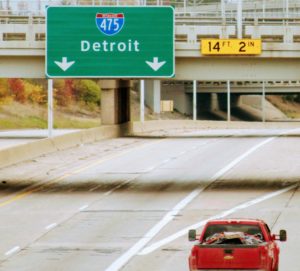By Tom Travis
(This article has been updated to reflect a change of venue for the March 22 meeting.)
The Michigan Department of Transportation (MDOT) has announced another in a series of public meetings for public input on the I-475 corridor for 5:30 p.m. Tuesday, March 22 followed by another presentation at 6:15 p.m. The meeting will be held at The Whiting, 1241 East Kearsley Street in Flint. COVID safety precautions will be followed and masks will be required indoors.

According to a press release, MDOT is seeking input from the public on how the corridor could be improved to meet the needs of all residents, commuters and business or property owners in the area. The first public input meeting was held in September, 2021, at the Flint Farmers Market.
The online presentation will be available from March 21 through April 4. Access to the meeting is available at bit.ly/I475OnlineMeeting.
Public feedback to MDOT can be also be given through email at MDOT-I475@Michigan.gov or by calling (517) 335-4381.

Residents stand over aerial view photos of I-475 pointing out landmarks and writing down their questions and suggestions on sticky notes for MDOT to consider. Sept. 15, 2021. (Photo by Tom Travis)
In the Fall of 2021, MDOT announced it would invest $300 million to rebuild I-475 from Bristol Road to Carpenter Road, estimating the work will begin in the Fall of 2023.
The proposed project is an eight-mile span of roadway and will include bridge repairs and I-69 and I-475 interchange repairs. MDOT estimates the project will last from November 2023 to December 2027 and will provide for more than 3,800 jobs.
The PEL (Planning and Environmental Linkages) study is a collaborative process that considers environmental, community, and economic goals in the transportation planning process. To receive project updates and information regarding the I-475 PEL from MDOT use this link: I-475 Project Contact List.
The PEL study will include public community meetings throughout the city. MDOT officials have set up communication through email and text for residents, available by clicking this link. The PEL study will last until November 2022 when HNTB will present their findings to MDOT.
Analysis of social economic and environmental impacts
MDOT and consulting firm HNTB (Howard, Needles, Tammen & Bergendoff) representatives said in September the PEL study will allow Flint residents (referred to as “stakeholders” during the presentation) to engage and communicate their ideas.
A “screening process” will be used to identify a locally-accepted alternative for the I-475 corridor. The “screening process” will include:
Safety, cultural impacts, noise impacts, air quality impacts, pedestrian and non-motorized safety impacts, environmental justice impacts, social equity local and regional mobility needs, connectivity benefits for adjacent neighborhoods, economic impacts on local businesses, secondary and indirect impacts, impacts on local emergency responders, and consistency with approved local land uses plans.
The anticipated engagement with the “stakeholders” (Flint residents) will include local advisory committee and business advisory committee meetings (TBA), local government meetings, small group/one-on-one meetings, meeting people where they are and public meetings, according to the MDOT representatives.
Flint remembers St. John’s and Floral Park neighborhoods
At the initial MDOT public input meeting in Sept. 2021 both MDOT and HNTB representatives acknowledged the history and removal of the neighborhoods, St. John’s and Floral Park, when I-475 was originally built in the early 1970’s. Some residents present at the Sept. 2021 meeting brought up the issue of racism and social equity.

A Flint Central Park neighborhood member sits with I-475 rebuild handouts taking notes as MDOT officials explain the project. Sept. 15, 2021. (Photo by Tom Travis)
Included in MDOT’s presentation was a page depicting a 1936 photo of St. John’s neighborhood and the right-of-way map of the Floral Park neighborhood that was demolished for I-475. Both MDOT and HNTB representatives explained that the purpose of the year long PEL study is to avoid the mistakes of the past and to engage and listen to the community.
According to the press release, accommodations can be made for persons who require mobility, visual, hearing, written or other assistance for participation. Large print materials, auxiliary aids or the services of interpreters, signers, or readers are available upon request.
Please contact Orlando Curry at (517) 241-7462 or complete Form 2658 for American Sign Language on the Title VI website at bit.ly/MDOT-TitleVI.
EVM Managing Editor Tom Travis can be reached at tomntravis@gmail.com.


You must be logged in to post a comment.